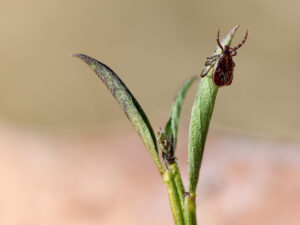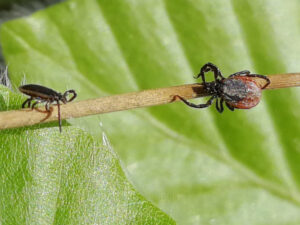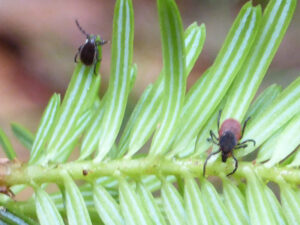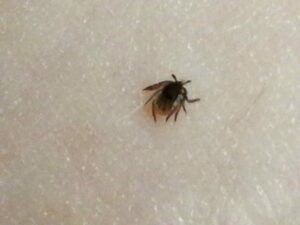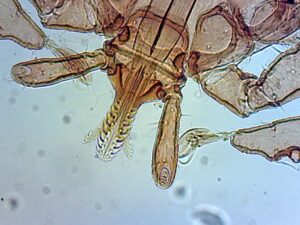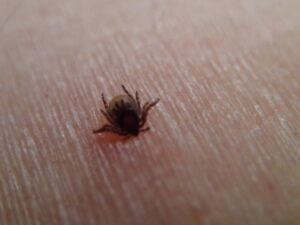Présentation
ACCÉDER À TOUS LES CENTRES D’EXPERTISE DU CHU DE STRASBOURG
Afin d’éviter les piqûres de tiques, les mesures de prévention primaire sont essentielles, à savoir des vêtements couvrants, de couleur claire et l’emploi éventuel de répulsifs. Si malgré cela, une tique est fixée sur votre peau, l’utilisation d’un « tire-tique » ou d’un système apparenté est efficace, sans application de produits sur la tique.
Pour connaître l’ensemble des mesures, vous pouvez notamment visualiser le support multimédia du site du CNR et vous reporter à l’article « The conversation »
Comment extraire une tique :
L’extraire le plus rapidement possible. Utiliser un tire-tique, une pince fine (comme illustré sur cette vidéo) voire une pince à épiler. Se placer le plus près possible de la peau et tirer délicatement. Désinfecter le point de piqûre et se laver les mains.
Si les pièces piqueuses n’ont pas pu être retirées complètement, elles peuvent être laissées en place dans la peau sans risque de transmission d’agent infectieux. Cela entrainera la formation d’un granulome qui disparaitra spontanément.
Pour plus d’information :
Figoni et al. Med Mal Infect. 2019.
Remove ticks safely – TickEncounter (uri.edu)
Les missions
Arrêté du 29 novembre 2004, modifié par l’arrêté du 5 juillet 2010, fixant les modalités de désignation et les missions des CNR.
- Apporter une expertise microbiologique
- Développer et diffuser des méthodes notamment moléculaires permettant d’améliorer le diagnostic des borrélioses, en particulier le diagnostic des différentes formes de la borréliose de Lyme,
- Améliorer ou développer des techniques de typage phénotypique et génotypique des Borrelia, tout particulièrement pour B. burgdorferi sensu lato,
- Contribuer à l’évaluation des tests sérologiques existants et à venir,
- Apporter son expertise aux laboratoires de biologie médicale (confirmation du diagnostic, typage),
- Collaborer avec les structures expertes en entomologie (tiques) et santé animale (faune sauvage) permettant de caractériser l’écologie des Borrelia.
- Contribuer, en lien avec l’Institut de veille sanitaire et les autres structures impliquées, à la surveillance épidémiologique et participer aux réseaux de surveillance internationaux, en particulier européens.
- Contribuer à l’alerte en signalant sans délai à l’INVS tout événement inhabituel : augmentation du nombre de cas ; apparition de cas groupés ; modification des formes cliniques (répartition, modification de leur expression clinique, formes inhabituelles) ; etc.
Le Centre de Référence Borrelia a été créé en 2002 et il était composé de deux équipes jusqu’en 2011. Une équipe à l’Institut Pasteur de Paris dont la mission était entomologique avec la surveillance du vecteur tique sur le territoire français. Une deuxième équipe à Strasbourg, laboratoire associé, dont la mission était le diagnostic de la borréliose de Lyme chez les patients.
Depuis le 1er janvier 2012, l’ensemble du CNR est localisé à Strasbourg avec les missions de diagnostic et de surveillance entomologique.
Le CNR Borrelia de Strasbourg a parmi ses missions celle de participer à l’épidémiologie vectorielle. Cela permet de mettre rapidement en parallèle des données vectorielles et des données humaines.
Pour cela, il réalise un suivi mensuel de l’activité des tiques Ixodes ricinus dans différents sites en Alsace (Bas-Rhin et Haut-Rhin) en autres. Ixodes ricinus est en effet le vecteur principal de la borréliose de Lyme mais aussi de l’anaplasmose à Anaplasma phagocytophilum, de l’encéphalite à tique et d’une espèce de Borrelia responsable de fièvre récurrente, B. miyamotoi.
Les tiques sont collectées au drapeau dans des sites forestiers de montagnes mais également de plaine et dans des sites périurbains.
Le pic maximum d’activité des tiques se situe en Alsace et en Bretagne d’avril à juin ; les tiques observent en Alsace une diapause hivernale qui n’existe pas en climat doux comme en Bretagne.
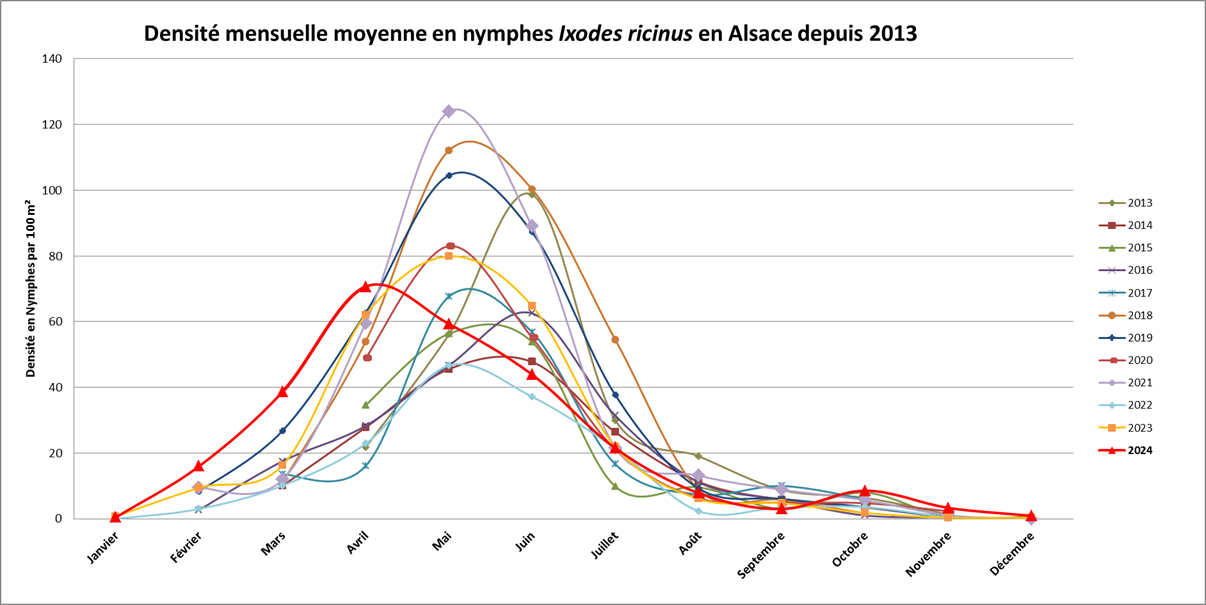
L’équipe
Centre National de Référence
- JAULHAC Benoît, Directeur du CNR : PU-PH, HDR, Faculté de Médecine
- BOULANGER Nathalie : PU-AH, HDR, Faculté de Pharmacie
- ZACHARY Pierre : Praticien attaché
- BOYER Pierre : MCU-PH
- GRILLON Antoine : MCU-PH
- TALAGRAND-REBOUL Emilie : MCU-PH
- ZILLIOX Laurence : Ingénieure hospitalier
- DOLLINGER Kévin : Technicien
- ENGEL Marine : Technicienne
- JENNY Eloé : Technicienne
- VIDAL Camille : Technicienne
Equipe recherche
- BOULANGER Nathalie, Responsable équipe de recherche : PU-AH, HDR, Faculté de Pharmacie
- JAULHAC Benoît : PU-PH, HDR, Faculté de Médecine
- HANSMANN Yves : PU-PH, HDR, Faculté de Médecine
- SCHRAMM Frédéric : MCU-PH, bactériologie
- LENORMAND Cédric : MCU-PH, dermatologie
- TALAGRAND-REBOUL Emilie : MCU-PH, bactériologie
- GRILLON Antoine : MCU-PH
- BOYER Pierre : MCU-PH, bactériologie
- BARTHEL Cathy : Ingénieur d’Etude
- WEISSHAUPT Sandi : AJT Université (50% ETP dans cette équipe)
Formulaires et documentation
Fiches d’informations / fiches techniques
Généralités sur la maladie de Lyme historique et épidémiologie
Autres maladies transmises par les tiques :
- Anaplasma
- Encéphalite à tique
- Tularémie
- Babesia
- Rickettsies
- Coxiella
- Fievres récurrentes
Fiches techniques :
En savoir plus
- Rapport annuel d’activité 2018
- Arrêt de la réalisation des IgM par le CNR des Borrelia
- BEH : numéro spécial Lyme
- Recommandations MVT 2019 Chap 1+2+3
- Recommandations MVT 2019 Chap 5+6+7
- Recommandations MVT 2019-diaporama-jni
- Lutte antivectorielle société de médecine des voyages
- Rapports d’activité : 2017– 2016 – 2012-2015 – 2014– 2013 – 2012
- Evaluation des trousses de sérologie Borrelia par immuno-empreinte
- Actualités sur les répulsifs – ANSES
- Film sur les activités du centre (site de l’université de Strasbourg)
Etude de validité de l’algorithme d’identification des cas de Borréliose de Lyme (BL) hospitalisés à partir du PMS : voir le document
Recherches et publications
Activités de recherche
Deux universitaires de l’équipe (Benoît Jaulhac, Nathalie Boulanger) exercent une partie de leur activité hospitalière au sein du Centre National de Référence (CNR) des Borrelia. Le CNR a des misions d’expertise, de surveillance épidémiologique, d’isolement, d’identification et de typage de souches. Cela permet au groupe de recherche d’avoir accès à une collection de souches et de prélèvements humains et environnementaux.
Mots clefs : Borrelia, tique, immunité innée, inflammation cutanée, protéomique
Notre thématique de recherche porte sur la borréliose de Lyme, infection bactérienne due à Borrelia burgdorferi sensu lato, transmis par la tique dure Ixodes. C’est la maladie à transmission vectorielle la plus fréquente de l’Hémisphère Nord, elle est endémique en Alsace et dans plusieurs pays européens. Nous nous intéressons à l’étude des interfaces essentielles rencontrées par la bactérie au cours de l’évolution de la maladie, dont la peau.
B. burgdorferi est transmise par la piqûre d’un arthropode-vecteur, la tique. Cette bactérie, en plus de son adaptation propre à l’environnement, utilise la salive de la tique pour faciliter sa survie chez l’hôte vertébré. Cette salive a un effet immunosuppresseur sur la réponse adaptative de l’hôte. L’effet de la salive de tique sur l’immunité innée de l’hôte vertébré est moins connu. Une protéine de tique, salp15 se fixe à une lipoprotéine de la bactérie, Osp C (outer surface protein) afin d’échapper à la reconnaissance par les cellules dendritiques et les lymphocytes T.
Nous analysons comment la bactérie, au moment de la piqûre, stimule l’immunité innée de la peau et la module grâce à la salive de tique, permettant la multiplication locale de Borrelia dans la peau puis sa dissémination vers les organes cibles : le système nerveux, l’articulation, le cœur et la peau à distance. Nous avons développé deux approches expérimentales pour étudier le rôle de l’interface cutanée et des cellules résidentes de la peau dans la survie de la bactérie : un modèle in vitro sur cellules primaires humaines et un modèle in vivo sur souris. Nous analysons comment le site initial cutané est essentiel pour la pathogénie ultérieure de la bactérie. Nous avons montré que la bactérie induit une inflammation cutanée qui est réprimée par un extrait brut de glandes salivaires de tiques. Ce travail vise à définir le rôle de la tique dans le cycle de développement de la bactérie, et à identifier des protéines clefs de la salive comme éléments de la pathogénicité pour la bactérie.
Le pathogène Borrelia, doit s’adapter à ses différents hôtes (tique, oiseaux, mammifères) où il rencontre des conditions de développement très variées notamment en terme de pH, température, pression en O2 et en CO2. Borrelia modifie alors son métabolisme et son antigènicité pour permettre sa survie. Nous identifions par protéomique et spectrométrie de masse les protéines de Borrelia impliquées dans ces processus adaptatifs essentiels et dans le processus de virulence. Nous analysons aussi la peau comme site de persistance de Borrelia, processus observé dans différentes pathologies à transmission vectorielle (paludisme, leishmaniose, trypanosomiase…).
L’étude sur le vecteur et l’identification des protéines de Borrelia par protéomique au niveau de la peau devraient permettre la mise au point de nouveaux outils diagnostiques et/ou la mise au point d’un vaccin.
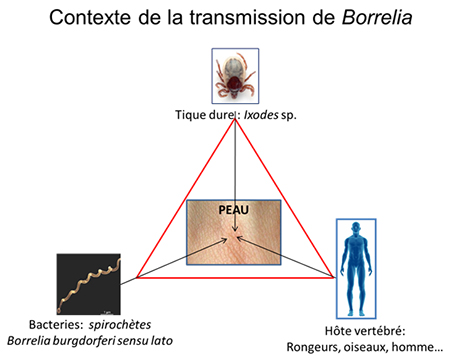
Principales publications
2023
- Fu W., Bonnet C., Septfons A., Figoni J., Durand J., Frey-Klett P., Rustand D., Jaulhac B., Métras R. Spatial and seasonal determinants of Lyme borreliosis incidence in France, 2016 to 2021. Euro Surveill. 2023 Apr;28(14). doi: 10.2807/1560-7917.ES.2023.28.14.2200581.
- Bonnet C., Figoni J., Souty C., Septfons A., De Martino S., de Valk H., Fournier L. Hanslik T., Jaulhac B., Blanchon T. Prevalence and factors asspociated with a prescription of a Lyme borreliosis serology for Erythema migrans diagnosis in general practice : a study from the French Sentinel network, 2009-2020. BMC Primary Care, 2023 Aug. 24;24(1):163.
- Baquer F., Jaulhac B., Barthel C., Paz M., Wolfgramm J., Müller A., Boulanger N., Grillon A. Skin microbiota secretomes modulate cutaneous innate immunity against Borrelia burgdorferi s. Sci Rep. 2023 Sep 29;13(1):16393.
- Septfons A., Rigaud E., Bénézet L., Velay A., Zilliox L., Baldinger L., Gonzalez G., Figoni J., de Valk H., Deffontaines G., Desenclos J.C., Jaulhac B.Seroprevalence for Borrelia burgdorferisensu lato and tick-borne encephalitis virus antibodies and associated risk factors among forestry workers in northern France, 2019 to 2020. Euro Surveill. 2023 Aug;28(32):2200961.
- Koual R., Buysse M., Grillet J., Binetruy F., Ouass S., Sprong H., Duhayon M., Boulanger N., Jourdain F., Alafaci A., Verdon J., Verheyden H., Rispe C., Plantard O., Duron O. (2023). Phylogenetic evidence for a clade of tick-associated trypanosomes. Parasites & Vectors. 16:3
- Saegerman C, Humblet MF, Leandri M, Gonzalez G, Heyman P, Sprong H, L’Hostis M, Moutailler S, Bonnet SI, Haddad N, Boulanger N, Leib SL, Hoch T, Thiry E, Bournez L, Kerlik J, Velay A, Jore S, Jourdain E, Gilot-Fromont E, Brugger K, Geller J, Studahl M, Knap N, Avšič-Županc T, Růžek D, Zomer TP, Bødker R, Berger TFH, Martin-Latil S, De Regge N, Raffetin A, Lacour SA, Klein M, Lernout T, Quillery E, Hubálek Z, Ruiz-Fons F, Estrada-Peña A, Fravalo P, Kooh P, Etore F, Gossner CM, Purse B. (2023) First Expert Elicitation of Knowledge on Possible Drivers of Observed Increasing Human Cases of Tick-Borne Encephalitis in Europe. Viruses;15(3):791. doi: 10.3390/v15030791.
- Perez, Bournez L., Boulanger N.,Fite J., Livoreil B., McCoy K.D., Quillery E., Rene-Martellet M., Bonnet S.I. (2023) The distribution, phenology, host range and pathogen prevalence of Ixodes ricinus in France: a systematic map and narrative review. BioRxiv. doi: https://doi.org/10.1101/2023.04.18.537315.
- Ouass S, Boulanger N, Lelouvier B, Insonere JL, Lacroux C, Krief S, Asalu E, Rahola N, Duron O. (2023) Diversity and phylogeny of the tick-borne bacterial genus Candidatus Allocryptoplasma (Anaplasmataceae). 2023;30:13. doi: 10.1051/parasite/2023014. PMID: 37162293
- Boulanger, Insonere JL., Van Blerk S., Barthel C., Serres C., Rais O., Roulet A., Servant F., Duron O., Lelouvier B. (2023). Cross alteration of murine skin and tick microbiomes concomitant with pathogen transmission after Ixodes ricinus bite. Microbiome;11(1):250. doi: 10.1186/s40168-023-01696-7. PMID:37952001; PMCID: PMC10638774.
- Boulanger, Wikel S. (2023). Vaccines against tick-borne diseases: a big step forward? Trends Parasitol., 39(12):989-990. doi:10.1016/j.pt.2023.10.001. Epub 2023 Oct 12. PMID: 37838513.
- Boulanger N. Anthropisation et maladies à tique : l’exemple de la borréliose de Lyme. Comptes Rendus Biologies 346(S1):1-7- Académie des Sciences-2023, DOI: 5802/crbiol.115
- Boulanger N. Tiques et maladies à tiques : en expansion et quels risques ? Pédiatrie pratique, 2023.
2022
- Bourgeois B, Koloski C, Foley-Eby A, Zinck CB, Hurry G, Boulanger N, Voordouw MJ. Clobetasol increases the abundance of Borrelia burgdorferi in the skin 70 times more in male mice compared to female mice. Ticks Tick Borne Dis. 2022 Oct 17;13(6):102058. doi: 10.1016/j.ttbdis.2022.102058. Epub ahead of print. PMID:36288683.
- Boyer PH, Lenormand C, Jaulhac B, Talagrand-Reboul E. Human Co-Infections between <i>Borrelia burgdorferi s.l. and Other Ixodes-Borne Microorganisms: A Systematic Review. Pathogens. 2022 Feb 23;11(3):282. doi:10.3390/pathogens11030282. PMID: 35335606; PMCID: PMC8948674.
- Boyer PH, Barthel C, Mohseni-Zadeh M, Talagrand-Reboul E, Frickert M, Jaulhac B, Boulanger N. Impact of Different Anthropogenic Environments on Ticks and Tick-Associated Pathogens in Alsace, a French Region Highly Endemic for Tick-Borne Diseases. Microorganisms. 2022 Jan 23;10(2):245. doi: 10.3390/microorganisms10020245. PMID: 35208700; PMCID: PMC8877010.
- Del Giudice P, Reverte M, Giraudon E, Durant J, Ahmed Abdoulah S, Jaulhac B, Poirier JP. First case of documented Lyme borreliosis in the Alpes-Maritimes department of South-Eastern France: Erythema chronicum migrans associated with Borrelia afzelii. Ann Dermatol Venereol. 2022 Jun;149(2):146-147. doi:10.1016/j.annder.2021.12.003. Epub 2022 Feb 17. PMID: 35184901.
- Duffau P, Korbi S, Guillotin V, Talagrand-Reboul E, Ménard A, Peuchant O. An unexpected case of Borrelia garinii liver infection. Ann Clin Microbiol Antimicrob. 2022 Mar 27;21(1):15. doi: 10.1186/s12941-022-00506-6. PMID 35346214; PMCID: PMC8958789.
- Klopfenstein T, Fournier D, Gendrin V, Garnier P, Grillon A, Zayet S. Lyme neuroborreliosis: warning about the risk of false negative of CSF Borrelia burgdorferi antibody index related to high level of CSF albumin. Eur J Clin Microbiol Infect Dis. 2022 Aug;41(8):1151-1153. doi: 10.1007/s10096-022-04471-y. Epub 2022 Jul 5. PMID: 35788833.
2021
- Boulanger N, Wikel S. Induced Transient Immune Tolerance in Ticks and Vertebrate Host: A Keystone of Tick-Borne Diseases? Front Immunology, 2021;12:625993. doi: 10.3389/fimmu.2021.625993. https://pubmed.ncbi.nlm.nih.gov/33643313/
- Boyer PH, Baldinger L, Degeilh B, Wirth X, Kamdem CM, Hansmann Y, Zilliox L, Boulanger N, Jaulhac B. The emerging tick-borne pathogen Neoehrlichia mikurensis: first French case series and vector epidemiology. Emerging Microbes & Infections. 2021 Dec;10(1):1731-1738. doi: 10.1080/22221751.2021.1973347. https://pubmed.ncbi.nlm.nih.gov/34432610/
- Norte AC, Boyer PH, Castillo-Ramirez S, Chvostáč M, Brahami MO, Rollins RE, Woudenberg T, Didyk YM, Derdakova M, Núncio MS, Carvalho IL, Margos G, Fingerle V. The Population Structure of Borrelia lusitaniae Is Reflected by a Population Division of Its Ixodes Vector. Microorganisms. 2021 Apr 27;9(5):933. doi: 10.3390/microorganisms9050933. https://pubmed.ncbi.nlm.nih.gov/33925391/
- Gaudin M, Tanguy G, Plagne M, Saussac A, Hansmann Y, Jaulhac B, Kelly M, Ouchchane L, Lesens O; expert group for the teaching of Lyme disease. E-learning versus face-to-face training: Comparison of two learning methods for Lyme borreliosis. Infectious Diseases Now. 2021 Nov 9:S2666-9919(21)00538-8. doi: 10.1016/j.idnow.2021.11.001.
- Tabor AE, de Miranda Santos IKF, Boulanger N.Editorial: Ticks and Host Immunity – New Strategies for Controlling Ticks and Tick-Borne Pathogens. Front Immunol. 2021 Nov 18;12:796558. doi: 10.3389/fimmu.2021.796558. eCollection 2021.PMID: 34868085
- Perez G., Boulouis HJ, Bonnet S., Boulanger N., Livoreil B., Mccoy K, Quillery E., Bournez L., René M., Fite J. Rapport bibliographique sur l’écologie, l’épidémiologie, la surveillance, la prévention et la lutte contre la tique Ixodes ricinus en France métropolitaine. Rapport ANSES 2021 – Archive ouverte HAL (archives-ouvertes.fr)
2020
- Bernard Q, Grillon A, Lenormand C, Ehret-Sabatier L, Boulanger N. Skin Interface, a Key Player for Borrelia Multiplication and Persistence in Lyme Borreliosis.Trends Parasitol. 2020 Mar;36(3):304-314. doi: 10.1016/j.pt.2019.12.017. Epub 2020 Jan 29.PMID: 32007396
- Binetruy F, Garnier S, Boulanger N, Talagrand-Reboul É, Loire E, Faivre B, Noël V, Buysse M, Duron O. A novel Borrelia species, intermediate between Lyme disease and relapsing fever groups, in neotropical passerine-associated ticks. Sci Rep. 2020 Jun 30;10(1):10596. doi: 10.1038/s41598-020-66828-7.PMID: 32606328
- Talagrand-Reboul E, Westermann B, Raess MA, Schnell G, Cantero P, Barthel C, Ehret-Sabatier L, Jaulhac B, Boulanger N. Proteomic as an Exploratory Approach to Develop Vaccines Against Tick-Borne Diseases Using Lyme Borreliosis as a Test Case.
Vaccines (Basel). 2020 Aug 21;8(3):463. doi: 10.3390/vaccines8030463.PMID: 32825641 - Lefeuvre B, Cantero P, Ehret-Sabatier L, Lenormand C, Barthel C, Po C, Parveen N, Grillon A, Jaulhac B, Boulanger N. Effects of topical corticosteroids and lidocaine on Borrelia burgdorferi sensu lato in mouse skin: potential impact to human clinical trials.
Sci Rep. 2020 Jun 29;10(1):10552. doi: 10.1038/s41598-020-67440-5.PMID: 32601348 - Boyer PH, Koetsveld J, Zilliox L, Sprong H, Talagrand-Reboul É, Hansmann Y, de Martino SJ, Boulanger N, Hovius JW, Jaulhac B. Assessment of Borrelia miyamotoi in febrile patients and ticks in Alsace, an endemic area for Lyme borreliosis in France.
Parasit Vectors. 2020 Apr 17;13(1):199. doi: 10.1186/s13071-020-04071-9.PMID: 32303256 - Talagrand-Reboul E, Raffetin A, Zachary P, Jaulhac B, Eldin C. Immunoserological Diagnosis of Human Borrelioses: Current Knowledge and Perspectives.
Front Cell Infect Microbiol. 2020 May 19;10:241. doi: 10.3389/fcimb.2020.00241. eCollection 2020.PMID: 32509603
2019
- Boeuf A, Schnell G, Bernard Q, Kern A, Westermann B, Ehret-Sabatier L, Grillon A, Schramm F, Jaulhac B, Boulanger N. Dissociating effect of salivary gland extract from Ixodes ricinus on human fibroblasts: Potential impact on Borrelia transmission. Ticks Tick Borne Diseases. 2019 Feb;10(2):433-441. IF=3.055 https://www.ncbi.nlm.nih.gov/pubmed/30595500
- Boulanger N, Boyer P, Talagrand-Reboul E, Hansmann Y. Ticks and tick-borne diseases. Médecine & Maladies Infectieuses. 2019 Mar;49(2):87-97. doi: 10.1016/j.medmal.2019.01.007. IF=1.289 https://www.ncbi.nlm.nih.gov/pubmed/30736991
- Eldin C, Jaulhac B, Mediannikov O, Arzouni JP, Raoult D. Values of diagnostic tests for the various species of spirochetes. Médecine & Maladies Infectieuses. 2019 Mar;49(2):102-111. doi: 10.1016/j.medmal.2019.01.009.https://www.ncbi.nlm.nih.gov/pubmed/30765286 IF=1.289
- Hansmann Y, Jaulhac B, Kieffer P, Martinot M, Wurtz E, Dukic R, Boess G, Michel A, Strady C, Sagez JF, Lefebvre N, Talagrand-Reboul E, Argemi X, De Martino S. Value of PCR, Serology, and Blood Smears for Human Granulocytic Anaplasmosis Diagnosis, France. Emerging Infectious Diseases. 2019 May;25(5):996-998. IF=7.185 https://www.ncbi.nlm.nih.gov/pubmed/31002073
- Septfons A, Goronflot T, Jaulhac B, Roussel V, De Martino S, Guerreiro S, Launay T, Fournier L, De Valk H, Figoni J, Blanchon T, Couturier E. Epidemiology of Lyme borreliosis through two surveillance systems: the national Sentinelles GP network and the national hospital discharge database, France, 2005 to 2016. EuroSurveillance. 2019 Mar;24(11). doi: 10.2807/1560-7917.ES.2019.24.11.1800134. IF=7.421 https://www.ncbi.nlm.nih.gov/pubmed/30892181
- Petney TN, Saijuntha W, Boulanger N, Chitimia-Dobler L, Pfeffer M, Eamudomkarn C, Andrews RH, Ahamad M, Putthasorn N, Muders SV, Petney DA, Robbins RG. Ticks (Argasidae, Ixodidae) and tick-borne diseases of continental Southeast Asia. Zootaxa. 2019 Feb 17;4558(1):1-89. doi: 10.11646/zootaxa.4558.1.1. IF=0.99 https://www.ncbi.nlm.nih.gov/pubmed/30790915
- Gomez-Chamorro A, Battilotti F, Cayol C, Mappes T, Koskela E, Boulanger N, Genné D, Sarr A, Voordouw MJ. Susceptibility to infection with Borrelia afzelii and TLR2 polymorphism in a wild reservoir host. Scientific Reports, 2019 Apr 30;9(1):6711. doi: 10.1038/s41598-019-43160-3. IF=4.011 https://www.ncbi.nlm.nih.gov/pubmed/31040326
- Boulanger N, Boyer P, Talagrand-Reboul E, Hansmann Y. Ticks and tick-borne diseases. Médecine et Maladies Infectieuses, 2019 Mar;49(2):87-97. IF=1.289 https://www.ncbi.nlm.nih.gov/pubmed/30736991
- Figoni J, Chirouze C, Hansmann Y, Lemogne C, Hentgen V, Saunier A, Bouiller K, Gehanno JF, Rabaud C, Perrot S, Caumes E, Eldin C, de Broucker T, Jaulhac B, Roblot F, Toubiana J, Sellal F, Vuillemet F, Sordet C, Fantin B, Lina G, Gocko X, Dieudonné M, Bodaghi B, Gangneux JP, Degeilh B, Partouche H, Lenormand C, Sotto A, Raffetin A, Monsuez JJ, Michel C, Boulanger N, Cathebras P, Tattevin P; endorsed by scientific societies. Lyme borreliosis and other tick-borne diseases. Guidelines from the French Scientific Societies (I): prevention, epidemiology, diagnosis. Médecine et Maladies Infectieuses. 2019 May 13. pii: S0399-077X(19)30116-7. IF=1.289 https://www.ncbi.nlm.nih.gov/pubmed/31097370
- Jaulhac B, Saunier A, Caumes E, Bouiller K, Gehanno JF, Rabaud C, Perrot S, Eldin C, de Broucker T, Roblot F, Toubiana J, Sellal F, Vuillemet F, Sordet C, Fantin B, Lina G, Sobas C, Gocko X, Figoni J, Chirouze C, Hansmann Y, Hentgen V, Cathebras P, Dieudonné M, Bodaghi B, Gangneux JP, Degeilh B, Partouche H, Lenormand C, Sotto A, Raffetin A, Monsuez JJ, Michel C, Boulanger N, Lemogne C, Tattevin P; société française de dermatologie (SFD), Lyme borreliosis and other tick-borne diseases. Guidelines from the French scientific societies (II). Biological diagnosis, treatment, persistent symptoms after documented or suspected Lyme borreliosis. Médecine et Maladies Infectieuses. 2019 May 31. pii: S0399-077X(19)30131-3. IF=1.289 https://www.ncbi.nlm.nih.gov/pubmed/31155367
- Nebbak A, Dahmana H, Almeras L, Raoult D, Boulanger N, Jaulhac B, Mediannikov O, Parola P. Co-infection of bacteria and protozoan parasites in Ixodes ricinus nymphs collected in the Alsace region, France. Ticks & Tick Borne Diseases. 2019 Oct;10(6):101241. IF=3.055 https://www.ncbi.nlm.nih.gov/pubmed/31279737
- Gocko X, Lenormand C, Lemogne C, Bouiller K, Gehanno JF, Rabaud C, Perrot S, Eldin C, de Broucker T, Roblot F, Toubiana J, Sellal F, Vuillemet F, Sordet C, Fantin B, Lina G, Sobas C, Jaulhac B, Figoni J, Chirouze C, Hansmann Y, Hentgen V, Caumes E, Dieudonné M, Bodaghi B, Gangneux JP, Degeilh B, Partouche H, Saunier A, Sotto A, Raffetin A, Monsuez JJ, Michel C, Boulanger N, Cathebras P, Tattevin P, Picone O; endorsed by the following scientific societies. Lyme borreliosis and other tick-borne diseases. Guidelines from the French scientific societies. Médecine et Maladies Infectieuses. 2019 Aug;49(5):296-317 IF=1.289 https://www.ncbi.nlm.nih.gov/pubmed/31257066
- Raffetin A, Saunier A, Bouiller K, Caraux-Paz P, Eldin C, Gallien S, Jouenne R, Belkacem A, Salomon J, Patey O, Talagrand-Reboul E, Jaulhac B, Grillon A. Unconventional diagnostic tests for Lyme borreliosis: a systematic review. Clinical Microbiology & Infection. 2019 Jul 12. pii: S1198-743X(19)30388-X. IF=6.425 https://www.ncbi.nlm.nih.gov/pubmed/31306793
- Ruiz VH, Edjolo A, Roubaud-Baudron C, Jaulhac B, Avila-Funes JA, Dartigues JF, Amieva H, Pérès K. Association of Seropositivity to Borrelia burgdorferi With the Risk of Neuropsychiatric Disorders and Functional Decline in Older Adults: The Aging Multidisciplinary Investigation Study. JAMA Neurology 2019 Sep 27. doi: 10.1001/jamaneurol.2019.3292. IF=12.321 https://www.ncbi.nlm.nih.gov/pubmed/31560067
- Boyer PH, Almeras L, Plantard O, Grillon A, Talagrand-Reboul É, McCoy K, Jaulhac B, Boulanger N. Identification of closely related Ixodes species by protein profiling with MALDI-TOF mass spectrometry. PLoS One. 2019 Oct 17;14(10):e0223735. doi: 10.1371/journal.pone.0223735. IF=2.776 https://www.ncbi.nlm.nih.gov/pubmed/31622384
2018
- Boyer PH, Deboscker S, Hernandez C, Ramsheyi M, Schneider P, Foeglé J, Lavigne T. An Undiagnosed Index Case Leading to a Nosocomial Scabies Outbreak: How Mass Single-Dose Ivermectin Treatment Can Help Control a Nosocomial Epidemic. Infection Control & Hospital Epidemiology 2018 Feb 19:1-2. doi: 10.1017/ice.2018.31. https://www.ncbi.nlm.nih.gov/pubmed/29457578 IF=2.856
- Boyer PH, Kieffer P, de Martino SJ, Zilliox L, Vogel JY, Jaulhac B, Hansmann Y. Borrelia burgdorferi sl and tick-borne encephalitis virus coinfection in Eastern France. Médecine & Maladies Infectieuses. 2018, 48(3):218-220. doi: 10.1016/j.medmal.2017.10.006. IF=1.606 https://www.ncbi.nlm.nih.gov/pubmed/29449048
- Goldstein V., Boulanger N., Schwartz D., George JC., Ertlen D., Zilliox L., Schaeffer M., Jaulhac B. Factors responsible for Ixodes ricinus nymph abundance: are soil features indicators of tick abundance in a French region where Lyme borreliosis is endemic? Tick and Tick borne diseases, 2018, 9(4):938-944. doi: 10.1016/j.ttbdis.2018.03.013. IF=3.182 https://www.ncbi.nlm.nih.gov/pubmed/29606622
- Talagrand-Reboul E., Boyer PH, Bergström S., Vial L., Boulanger N. Relapsing fevers: neglected tick-borne diseases. Frontiers in Cellular and Infectious Microbiology, 2018, 8:98. doi: 10.3389/fcimb.2018.00098 IF=3.518 https://www.ncbi.nlm.nih.gov/pubmed/29670860
- Gallais F, De Martino SJ, Sauleau EA, Hansmann Y, Lipsker D, Lenormand C, Talagrand-Reboul E, Boyer PH, Boulanger N, Jaulhac B, Schramm F. Multilocus sequence typing of clinical Borreliella afzelii strains: population structure and differential ability to disseminate in humans. Parasite Vectors, 2018, 11(1):374. doi: 10.1186/s13071-018-2938-x. IF=3.031 https://www.ncbi.nlm.nih.gov/pubmed/29954419
- Grillon A, Scherlinger M, Boyer PH, De Martino S, Perdriger A, Blasquez A, Wipff J, Korganow AS, Bonnard C, Cantagrel A, Eyer D, Guérin F, Monteiro I, Woehl JM, Moreau P, Pennaforte JL, Lechevallier J, Bastides F, Colombey A, Imbert I, Maugars Y, Gicquel P, Cuchet F, Brax M, Sibilia J, Zilliox L, Barthel C, Arnaud L, Jaulhac B. Characteristics and clinical outcomes after treatment of a national cohort of PCR-positive Lyme arthritis. Seminars in Arthritis Rheumatism. 2018 Sep 28. pii: S0049-0172(18)30424-4. doi: 10.1016/j.semarthrit.2018.09.007.IF=5.072 https://www.ncbi.nlm.nih.gov/pubmed/30344080
- Robinot R, Bachy E, Chaubard S, Urb M, Carras S, Bardel E, Chartoire D, Traverse-Glehen A, Marche PN, Salles G, Jaulhac B, Genestier L. Chronic Borrelia burgdorferi infection triggers NKT lymphomagenesis. Blood. 2018 Nov 2. pii: blood-2018-07-863381. doi: 10.1182/blood-2018-07-863381. IF=15.562 https://www.ncbi.nlm.nih.gov/pubmed/30389696
- Eldin C, Raffetin A, Bouiller K, Hansmann Y, Roblot F, Raoult D, Parola P. Review of European and American guidelines for the diagnosis of Lyme borreliosis. Médecine et Maladies Infectieuses. 2018 Dec 6. pii: S0399-077X(18)30676-0. doi: 10.1016/j.medmal.2018.11.011. IF=1.289 https://www.ncbi.nlm.nih.gov/pubmed/30528068
- Boulanger N. Immunomodulatory effect of tick saliva in pathogen transmission]. Biol Aujourdhui. 2018;212(3-4):107-117. doi: 10.1051/jbio/2019001. https://www.ncbi.nlm.nih.gov/pubmed/30973140
2017
- Grillon A, Westermann B, Cantero P, Jaulhac B, Voordouw MJ, Kapps D, Collin E, Barthel C, Ehret-Sabatier L, Boulanger N. Identification of Borrelia protein candidates in mouse skin for potential diagnosis of disseminated Lyme borreliosis. Sci Rep. 2017 Dec 1;7(1):16719.
- Boyer PH, Boulanger N, Nebbak A, Collin E, Jaulhac B, Almeras L. Assessment of MALDI-TOF MS biotyping for Borrelia burgdorferi sl detection in Ixodes ricinus. PLoS One. 2017 Sep 26;12(9):e0185430.
- Bernard Q, Wang Z, Di Nardo A, Boulanger N. Interaction of primary mast cells with Borrelia burgdorferi (sensu stricto): role in transmission and dissemination in C57BL/6 mice. Parasit Vectors. 2017 Jun 27;10(1):313.
- Boyer PH, De Martino SJ, Hansmann Y, Zilliox L, Boulanger N, Jaulhac B. No evidence of Borrelia mayonii in an endemic area for Lyme borreliosis in France. Parasit Vectors. 2017 Jun 5;10(1):282. doi: 10.1186/s13071-017-2212-7.
2016
- Bernard, Q., Gallo, R.L., Jaulhac, B., Nakatsuji, T., Luft, B., Yang, X., and Boulanger, N. (2016). Ixodes tick saliva suppresses the keratinocyte cytokine response to TLR2/TLR3 ligands during early exposure to Lyme borreliosis. Experimental Dermatology 25, 26-31.
- Leeflang, M.M.G., Ang, C.W., Berkhout, J., Bijlmer, H.A., Van Bortel, W., Brandenburg, A.H., Van Burgel, N.D., Van Dam, A.P., Dessau, R.B., Fingerle, V., et al. (2016). The diagnostic accuracy of serological tests for Lyme borreliosis in Europe: a systematic review and meta-analysis. BMC infectious diseases 16, 140.
- Lenormand, C., Jaulhac, B., Debarbieux, S., Dupin, N., Granel-Brocard, F., Adamski, H., Barthel, C., Cribier, B., and Lipsker, D. (2016). Expanding the clinicopathological spectrum of late cutaneous Lyme borreliosis (acrodermatitis chronica atrophicans ): A prospective study of 20 culture- and/or polymerase chain reaction (PCR)-documented cases. Journal of the American Academy of Dermatology 74, 685-692.
- N’Guyen Y, Lesaffre F, Metz D, de Martino S, Jaulhac B, Andréoletti L. No serological evidence for Borrelia burgdorferi sensu lato infection in patients with dilated cardiomyopathy in Northern France. Infect Dis (Lond). 2016 Jun 22:1-2.
- Rigaud E, Jaulhac B, Garcia-Bonnet N, Hunfeld KP, Féménia F, Huet D, Goulvestre C, Vaillant V, Deffontaines G, Abadia-Benoist G. Seroprevalence of seven pathogens transmitted by the Ixodes ricinus tick in forestry workers in France. Clin Microbiol Infect. 2016 May 26. pii: S1198-743X(16)30141-0.
2015
- Bernard, Q., Jaulhac, B., and Boulanger, N. (2015). Skin and arthropods: an effective interaction used by pathogens in vector-borne diseases. European journal of dermatology 25, 18-22.
- Boulanger, N., and Lipsker, D. (2015). Protection contre les piqûres de tiques. . Annales De Dermatologie Et De Vénéréologie 142, 245-251.
- Dessau, R.B., Fingerle, V., Gray, J., Hunfeld, K.P., Jaulhac, B., Kristoferitsch, W., Stanek, G., and Strle, F. (2015). The authors reply to comments on “The lymphocyte transformation test for the diagnosis of Lyme borreliosis has currently not been shown to be clinically useful.” Clin Microbiol Infect 2014;20:O786-O787. Clinical Microbiology and Infection 21, e21.
- Hansmann, Y., Cazenave-Roblot, F., Weinbreck, P., Michelet, C., and Caumes, E. (2015). Maladie de Lyme : où est la controverse ? . Presse Médicale 44, 697-699.
- Kern, A., Schnell, G., Bernard, Q., Bœuf, A., Jaulhac, B., Collin, E., Barthel, C., Ehret-Sabatier, L., and Boulanger, N. (2015). Heterogeneity of Borrelia burgdorferi Sensu Stricto Population and Its Involvement in Borrelia Pathogenicity: Study on Murine Model with Specific Emphasis on the Skin Interface. PloS One 10, e0133195.
- Kunze, U., and ISW-TBE (2015). Tick-borne encephalitis as a notifiable disease–Status quo and the way forward. Report of the 17th annual meeting of the International Scientific Working Group on Tick-Borne Encephalitis (ISW-TBE). Ticks and Tick-Borne Diseases 6, 545-548.
- Schnell, G., Boeuf, A., Jaulhac, B., Boulanger, N., Collin, E., Barthel, C., De Martino, S., and Ehret-Sabatier, L. (2015). Proteomic analysis of three Borrelia burgdorferi sensu lato native species and disseminating clones: relevance for Lyme vaccine design. Proteomics 15, 1280-1290.
- Schnell, G., Boeuf, A., Westermann, B., Jaulhac, B., Lipsker, D., Carapito, C., Boulanger, N., and Ehret-Sabatier, L. (2015). Discovery and targeted proteomics on cutaneous biopsies infected by borrelia to investigate lyme disease. Molecular & cellular proteomics: MCP 14, 1254-1264.
2014
- Bernard, Q., Jaulhac, B., and Boulanger, N. (2014). Smuggling across the border: how arthropod-borne pathogens evade and exploit the host defense system of the skin. The Journal of Investigative Dermatology 134, 1211-1219.
- Blanc, F., Philippi, N., Cretin, B., Kleitz, C., Berly, L., Jung, B., Kremer, S., Namer, I.J., Sellal, F., Jaulhac, B., et al. (2014). Lyme neuroborreliosis and dementia. Journal of Alzheimer’s disease: JAD 41, 1087-1093.
- Dessau, R.B., Fingerle, V., Gray, J., Hunfeld, K.P., Jaulhac, B., Kahl, O., Kristoferitsch, W., Stanek, G., and Strle, F. (2014). The lymphocyte transformation test for the diagnosis of Lyme borreliosis has currently not been shown to be clinically useful. Clinical Microbiology and Infection: The Official Publication of the European Society of Clinical Microbiology and Infectious Diseases 20, O786-O787.
- Hansmann, Y., Leyer, C., Lefebvre, N., Revest, M., Rabaud, C., Alfandari, S., Christmann, D., and Tattevin, P. (2014). Feedback on difficulties raised by the interpretation of serological tests for the diagnosis of Lyme disease. Médecine Et Maladies Infectieuses 44, 199-205.
- Pages, F., Dautel, H., Duvallet, G., Kahl, O., de Gentile, L., and Boulanger, N. (2014). Tick repellents for human use: prevention of tick bites and tick-borne diseases. Vector Borne and Zoonotic Diseases (Larchmont, NY) 14, 85-93.
- Schramm, F., Gauthier-Clerc, M., Fournier, J.-C., McCoy, K.D., Barthel, C., Postic, D., Handrich, Y., Le Maho, Y., and Jaulhac, B. (2014). First detection of Borrelia burgdorferi sensu lato DNA in king penguins (Aptenodytes patagonicus halli). Ticks and Tick-Borne Diseases 5, 939-942.
- Twizeyimana, E., Pichard, E., Lunel-Fabiani, F., Fanello, S., and De Martino, S.J. (2014). Impact of serodiagnosis on the management of Lyme borreliosis at Angers University Hospital. Médecine Et Maladies Infectieuses 44, 429-432.
- Vandenesch, A., Turbelin, C., Couturier, E., Arena, C., Jaulhac, B., Ferquel, E., Choumet, V., Saugeon, C., Coffinieres, E., Blanchon, T., et al. (2014). Incidence and hospitalisation rates of Lyme borreliosis, France, 2004 to 2012. Euro Surveillance 19, 20883.
2013
- Vu Hai, V., Pages, F., Boulanger, N., Audebert, S., Parola, P., and Almeras, L. (2013). Immunoproteomic identification of antigenic salivary biomarkers detected by Ixodes ricinus-exposed rabbit sera. Ticks and Tick-Borne Diseases 4, 459-468.
2012
- Edouard, S., Koebel, C., Goehringer, F., Socolovschi, C., Jaulhac, B., Raoult, D., and Brouqui, P. (2012). Emergence of human granulocytic anaplasmosis in France. Ticks and Tick-Borne Diseases 3, 403-405.
- Hidri, N., Barraud, O., de Martino, S., Garnier, F., Paraf, F., Martin, C., Sekkal, S., Laskar, M., Jaulhac, B., and Ploy, M.C. (2012). Lyme endocarditis. Clinical Microbiology and Infection 18, E531-E532.
- Koebel, C., Kern, A., Edouard, S., Hoang, A.T., Celestin, N., Hansmann, Y., Jaulhac, B., Brouqui, P., and De Martino, S.J. (2012). Human granulocytic anaplasmosis in eastern France: clinical presentation and laboratory diagnosis. Diagnostic Microbiology and Infectious Disease 72, 214-218.
- Kunze, U., and ISW-TBE (2012). Tick-borne encephalitis (TBE): an underestimated risk…still: report of the 14th annual meeting of the International Scientific Working Group on Tick-Borne Encephalitis (ISW-TBE). Ticks and Tick-Borne Diseases 3, 197-201.
- Levy, E., Morruzzi, C., Barbarini, A., Sordet, C., Cribier, B., Jaulhac, B., and Lipsker, D. (2012). Clinical images: toe dactylitis revealing late Lyme borreliosis. Arthritis and Rheumatism 64, 1293.
- Patramool, S., Choumet, V., Surasombatpattana, P., Sabatier, L., Thomas, F., Thongrungkiat, S., Rabilloud, T., Boulanger, N., Biron, D.G., and Missé, D. (2012). Update on the proteomics of major arthropod vectors of human and animal pathogens. Proteomics 12, 3510-3523.
- Sauer, A., Hansmann, Y., Jaulhac, B., Bourcier, T., and Speeg-Schatz, C. (2012). Les manifestations ophtalmologiques de la maladie de Lyme chez l’enfant : description de cinq cas et revue de la littérature. . Journal Français D’ophtalmologie 35, 17-22.
- Schramm, F., Kern, A., Barthel, C., Nadaud, S., Meyer, N., Jaulhac, B., and Boulanger, N. (2012). Microarray analyses of inflammation response of human dermal fibroblasts to different strains of Borrelia burgdorferi sensu stricto. PloS One 7, e40046.
2011
- Kern, A., Collin, E., Barthel, C., Michel, C., Jaulhac, B., and Boulanger, N. (2011). Tick saliva represses innate immunity and cutaneous inflammation in a murine model of Lyme disease. Vector Borne and Zoonotic Diseases (Larchmont, NY) 11, 1343-1350.
- Marchal, C., Schramm, F., Kern, A., Luft, B.J., Yang, X., Schuijt, T.J., Schuijt, T., Hovius, J.W., Hovius, J., Jaulhac, B., et al. (2011). Antialarmin effect of tick saliva during the transmission of Lyme disease. Infection and Immunity 79, 774-785.
- Sauer, A., Speeg-Schatz, C., and Hansmann, Y. (2011). Two cases of orbital myositis as a rare feature of lyme borreliosis. Case Reports in Infectious Diseases 2011, 372470.
- Stanek, G., Fingerle, V., Hunfeld, K.P., Jaulhac, B., Kaiser, R., Krause, A., Kristoferitsch, W., O’Connell, S., Ornstein, K., Strle, F., et al. (2011). Lyme borreliosis: clinical case definitions for diagnosis and management in Europe. Clinical Microbiology and Infection 17, 69-79.
INFORMATIONS PRATIQUES
Prendre rendez-vous
Venir à la consultation
Hôpital civil
Plateau technique de Microbiologie1 place de l'hôpital
BP 426
67091 Strasbourg cedex
Préparer sa consultation
Les documents indispensables
Pour faciliter et sécuriser votre prise en charge, vous devez vous munir à chaque consultation des documents suivants :
- Le courrier du médecin traitant ou spécialiste, des résultats d’examens complémentaires récents si existants : imagerie, biologie, …, de la copie des ordonnances médicamenteuses que vous prenez, de votre carte carte de groupe sanguin.
- Une des pièces d’identité officielles ci-dessous :
- Carte nationale d’identité ou d’un passeport (français ou étranger)
- Carte ou titre de séjour permanent ou temporaire
- Récépissé de demande de titre de séjour
- Titre d’identité républicain
- Document de circulation pour étranger mineur
- Pour les enfants sans pièce d’identité officielle : acte de naissance ou livret de famille + pièce d’identité officielle d’au moins un des parents
La carte vitale, le permis de conduire, une demande d’asile, une attestation d’aide médicale d’état (AME) ou une photocopie ou photo de la pièce d’identité officielle ne sont pas des pièces d’identité que nous pouvons accepter.
- Autres documents à présenter :
- Carte vitale à jour, attestation CMU lisible
- Prise en charge particulière (accident de travail, aide médicale d’état, prise en charge par un tiers, protocole de soins ALD, maternité …)
Le déroulé de la consultation
La consultation médicale à l’hôpital ne diffère pas de celle des autres médecins. Elle comporte plusieurs étapes :
- Le médecin vous posera des questions : la raison de votre venue, vos antécédents personnels ou familiaux, votre activité professionnelle.
- Il vous examine.
- Il peut prescrire des examens complémentaires : analyses biologiques, imagerie médicale (si nécessaire)
- Il réalise un diagnostic
- Il propose une prise en charge : consultation auprès d’un autre professionnel de santé, prescription d’examens, de traitements …
- Il peut recommander un suivi régulier.
N’hésitez pas à poser des questions, à vous faire expliquer un terme médical chaque fois que vous le jugez utile pour votre bonne compréhension.
Mon hospitalisation
Pour vous joindre, vos proches peuvent composer le 03 69 200 500 (appel non surtaxé)
Informations relatives à toutes les hospitalisations :
Les formalités d’admission, le livret d’accueil du patient …
Les aspects pratiques : télévision, téléphone, chambres, visites, repas, accompagnants, aumôneries, service social, interprétariat langue étrangère ou interprétariat maillon blanc(les interprètes et les intermédiateurs), …
Les informations relatives à votre sortie et la mesure de la satisfaction
Le paiement des frais de séjour
Précisions relatives à l’hospitalisation dans ce service de soins (si besoin)
Après ma consultation
Après la consultation, vous devrez peut-être réaliser des examens complémentaires. Prenez rapidement rendez-vous auprès du professionnel de santé de votre choix. Les délais peuvent être longs pour des examens spécialisés.
Si un nouveau rendez-vous est nécessaire, la secrétaire vous en fixera un.
Autour de la consultation
Dans certaines maladies chroniques ou graves, des actions sont mises en place autour de l’Education thérapeutique du patient. On pourra vous proposer de bénéficier de cette prise en charge qui vous permettra de mieux vivre avec votre maladie.
Des associations de malades ou de proches de malades peuvent aussi intervenir à l’hôpital ou en dehors. Vous pouvez les contacter si vous en ressentez le besoin. Voir la liste des associations conventionnées.
L'équipe


Mis à jour le 31/03/2025


